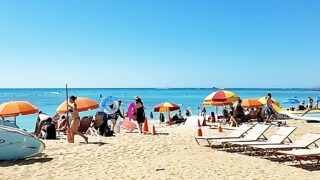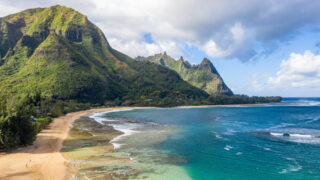Many visitors question if Hawaii still offers the value it once did. Travelers accustomed to finding an affordable retreat feel squeezed. With costs of visiting having risen dramatically, they now rival or exceed other global luxury destinations like French Polynesia and Europe.
That’s where leadership from the state’s Tourism is so important. But right now, there is no president and CEO of Hawaii’s HTA to guide the agency due to uncertainty between the governor and HTA, partly over the salary of their next top executive, competing priorities, and infighting between tourism stakeholders, government agencies, and community members.
HTA has been without a permanent leader for two years when former HTA President and CEO John DeFries opted not to pursue renewing his contract.
The lack of leadership has been another part of confusing visitors and residents about Hawaii’s core vision for tourism. Mixed messaging about whether Hawaii wants to attract more visitors or limit and direct arrivals towards its version of sustainable tourism has sparked frustration and left some reconsidering their plans.
Without decisive and consistent messaging and action, these global travel trends risk further eroding Hawaii’s appeal and visitor numbers.
Confusion over messaging from Hawaii’s leaders continues only to compound the issue.
A recurring sentiment among visitors is uncertainty: Does Hawaii want us to visit or stay away? Comments like these from readers highlight the growing frustration:
Samantha shared, “I’ve been to Hawaii over a dozen times, but it feels like the state is giving mixed signals. Between the rising costs and talk of limiting tourism, it’s hard to know if we’re still welcome.”
What can Hawaii learn from global peers?
We’re embarking on an in-depth investigation across key locations to understand better how global destinations address tourism challenges. From Europe to the Pacific, we’ll explore innovative strategies in sustainability, infrastructure, and visitor management that could provide valuable lessons for Hawaii.
Here are some of the places on our list:
Lauterbrunnen Valley in Switzerland. This town has seen a crush of visitors due to its strategic location as a major access point to the Swiss Alps. It is also overrun with Indian tourists who come here to see the filming site of their favorite movies. Last fall, the steepest tram in the world opened in Lauterbrunnen, bringing increased visitor traffic. The community has implemented measures to preserve its natural beauty while accommodating this massive influx of visitors. Efforts like limiting vehicle access and creating sustainable visitor itineraries are said to be helping balance tourism and local needs. The local community, however, feels overwhelmed.
Madeira, Portugal, often referred to as the “Hawaii of Europe,” this island has gained popularity partly due to its incredible natural beauty. At the same time, affordability and emphasis on sustainability remain in focus. It offers a paradise-like experience thus far, seemingly without Hawaii’s high costs or overtourism backlash. Will that change on this island, which gets about 20% of Hawaii’s annual visitors?
Venice, long a poster child for over-tourism, has taken bold steps to manage the influx of visitors threatening its delicate ecosystem and cultural heritage. With measures such as an access fee for day-trippers, restrictions on short-term rentals, and limits on large cruise ships, the city is attempting to balance preserving its iconic canals and supporting its tourism-driven economy. The effectiveness of these initiatives remains under scrutiny, making Venice a key destination for examining how major tourist hotspots adapt to 2025’s travel challenges.
The Cook Islands have emerged as a leader in sustainable tourism, balancing their economic reliance on visitors with a deep commitment to preserving their pristine environment and cultural heritage. The islands aim to ensure long-term sustainability through initiatives that focus on controlled growth, community-led tourism, and conservation programs. Their approach, which includes promoting responsible travel behaviors and limiting large-scale developments, offers valuable insights into how small island destinations can thrive while maintaining their unique character.
These are examples of places striving for clear communication, infrastructure investment, and a focus on sustainability in travel. We want to learn more about how Hawaii might adapt and thrive in a competitive global market.
As these destinations implement innovative leadership solutions, Hawaii faces mounting pressure to adapt or risk losing its competitive edge.
The broader consequences for Hawaii.
The ramifications of Hawaii’s tourism struggles extend far beyond our world-class beaches. Tourism is and will remain the cornerstone of the state’s economy, and ongoing mismanagement continues to risk alienating visitors, local businesses, and residents who rely on this industry.
This has a domino effect: fewer visitors mean less revenue, which could exacerbate existing issues like budget shortfalls and strained resources. For Hawaii, the stakes couldn’t be higher.
Can Hawaii recover from its tourism faceplant?
Hawaii’s challenges are significant, but they aren’t insurmountable. To recover, the state must address its leadership gaps, clarify and communicate its stance on tourism, and provide a sustainable travel roadmap that benefits visitors and residents.
With travel trends evolving rapidly, Hawaii must respond now to avoid the risk of falling behind as other destinations set the pace.
What changes do you think Hawaii should implement to remain competitive?
Get Breaking Hawaii Travel News







I am a former resident of Hawaii and often come back to visit family and friends.
However, in recent years the message to visitors have been mixed indeed. What was once a message of aloha and welcome seems at times to be one of “come and visit and spend your money and please don’t complain if we’re less than happy that you’re visiting.”
I get that balancing over tourism, lack of affordable housing for local residents, and trying to keep the wonderful flavor of the islands from deteriorating is a challenge….but pricing visitors out of the market in an attempt to attract only the demographic that is thought will work help seems absurd.
Hawaii used to be welcoming to all. The message now often appears.to be that it’s welcoming only to the rich….who may care about making use of your land…but not necessarily the best at caring for the land.
The way I see it, tourism isn’t about the natives enjoying it. It’s about the tourists enjoying their experience. If tourists feel animosity, they will simply go somewhere else. The result is that both sides loose.
As someone that had visited Hawaii as a family regularly, the elimination of affordable, family friendly acommodations has hit us hard. To visit and rent several hotel rooms for family is no longer affordable and the elimination of STR’s is short sighted. They provide a more affordable, family friendly platform and have a more desirable place to stay. Just like Uber and Lyft in the early days, STR’s are the better model for families visiting Hawaii and welcoming them has been pushed aside to the benefit of hotels who have raised rates to absurd levels!!
Is it just me, or does it feel like Hawaii is at a tipping point? Either they figure out how to manage tourism properly, and soon, or things could get even worse.
Visiting Hawaii isn’t just about beaches—it’s about culture and connection. I hope whatever changes come next, they don’t lose sight of what makes the islands truly special. This is a tightrope.
I still love Hawaii, but it’s true—traveling there feels more complicated and expensive than ever. Hopefully, some lessons learned from other tourist destinations can make a difference before it is too late.
We went to Madeira lat year, and honestly, it felt like a more affordable version Hawaii without all the added fees. Hawaii needs to step up its game before travelers like me look elsewhere permanently.
I get that Hawaii wants to balance tourism and sustainability, but mixed messaging isn’t helping. If even places like Venice can make bold moves, why can’t Hawaii figure it out? After all, it’s the only industry Hawaii has.
Sustainability?
There are at least 5 new hotels in downtown Honolulu, 1 new timeshare building in Waikiki, and a massive new resort planned for Ko Olina.
The politicians & lobbyists are anti vacation rental & pro hotel.
The lack of leadership in Hawaii is really concerning. It feels like no one knows what direction Hawaii tourism should take, and that uncertainty is driving visitors away.
Hawaii has always felt like such a special place, but with all the rising costs and confusion about tourism, I’m starting to wonder if it’s still worth it. Other destinations seem to be getting their act together better.
The wish of citizens and politicians of Hawaii for years was to curb over tourism by making the islands less affordable for vacationers to visit.
Through taxing STR’s and Resort Hotels room rates have nearly doubled forcing less desirable low budget tourist from visiting the islands.
It appears they’ve accomplish their goal, so where’s the beef?
My feelings are many of those priced out of travel to Hawaii were also the visitors who volunteered at animal shelters, Hawaiian cultural centers, food banks and learned the language.
They respect Hawaii’s wild life laws, they go out of the way to support local business, don’t trash the beach or individuals private property.
So is this the beef instead of pricing out selfish tourist you’ve priced out the visitor that actually cared about the people, land and culture of Hawaii.
Also airfares play a big part of coming to Hawaii.
I honestly believe Hawaii’s issues are irrecoverable. While tourism is the number one business in Hawaii, the focus of the administration and each island’s mayor is not to provide a world class sustainable experience for their visitors, but rather it’s all about the bottom line: money. Money drives all their decisions. Bring in the big corporations to build luxury hotels. Bring in the Zuckerberg’s and Oprah’s to pay exorbitant amounts of money for their properties. Raise taxes to some of the highest in the world. Squeeze every visitor to the max. Charge them for visiting our parks, parking their cars, and to top it all, charge them a fee just for stepping off the airplane. After 15+ visits to the islands, it breaks my heart to see what’s happened.
Good summary. I’m pretty sure the current state and country governments will not be successful at making the needed changes. It’s obviously not gotten bad enough to cause their retirement so keep hammering the points you’ve made home.
If Hawaii doesn’t first focus on it’s ecosystem and culture, tourism won’t be sustainable in the long run. If the ecosystem and culture do not thrive, neither will tourism. The hotel and short-term rental industries are only focused on short-term monetary gains. That mindset must change.